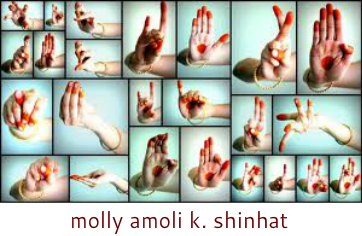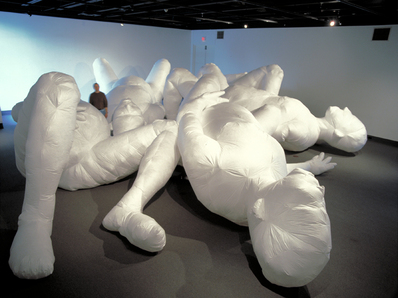Welcome to the machine: Sleeping Giants
Max Streicher
SAW Gallery
Lying flat on her back, asleep, on a sun-bleached train platform, the little girl looked like she was maybe five years old. The ragged shirt she wore once was white. Naked from the waist down, her legs ajar, I remember feeling the terror of her vulnerability—is there a position more vulnerable a human being can be in?
At about 20 foot long, Max Streicher's group Sleeping Giants, with their white Tyvek skin, recline on their backs, knees bent, and legs even further apart, constantly being inflated and slightly bobbed about by fans and motors. Compared to the little Indian girl, the giants are the same only in spatial position. In terms of tragedy, there's no comparison—one is a human being, a little girl, the other, a series of representations that in some way reminded me of her.
The whirring rhythmic noise made by the motors that keep the giants inflated sound just like someone operating an industrial sewing machine or the sounds of a factory full of them. Almost always women, often of Third Word ancestry and/or immigrants, piece-workers get paid per article of clothing they produce—not by the hour or by the day. Sometimes the women buy industrial machines and work from home. In this case, the reference conjured up the masses of sewers competing in sweatshop-like conditions in which brand-name clothing is so often produced.
At about 20 foot long, Max Streicher's group Sleeping Giants, with their white Tyvek skin, recline on their backs, knees bent, and legs even further apart, constantly being inflated and slightly bobbed about by fans and motors. Compared to the little Indian girl, the giants are the same only in spatial position. In terms of tragedy, there's no comparison—one is a human being, a little girl, the other, a series of representations that in some way reminded me of her.
The whirring rhythmic noise made by the motors that keep the giants inflated sound just like someone operating an industrial sewing machine or the sounds of a factory full of them. Almost always women, often of Third Word ancestry and/or immigrants, piece-workers get paid per article of clothing they produce—not by the hour or by the day. Sometimes the women buy industrial machines and work from home. In this case, the reference conjured up the masses of sewers competing in sweatshop-like conditions in which brand-name clothing is so often produced.
|
"They're all from the same pattern," says Streicher, by phone from Toronto. "As I sewed them, I got better at them and learned from them." The pattern for the giant took about a month to develop and each figure about a week of Streicher sewing full-time. With no articulated genitalia, generous stomachs, and small breasts, they appear asexual, and virtually identical, except for the tiny differences typical to some mass-production, even that done by machine. In the giants, it's the lines on their hands.
If you bother to look for it, the detail in the figures is quite remarkable, along with the way Streicher has represented the human face. Stripped of hair, colour, smell, it's striking how beautiful a "skeletal" version still looks regardless. "In the past I used other forms, abstract ones, but because of the breathing, of the inflation and deflation of air (in the pieces)," says Streicher, "They always reference the figure in some way. It (using the human figure) was a risky thing to do, because the figure has a particular baggage in contemporary art. I just felt they had a really spooky and evocative kind of presence." |
Beginning about a decade ago, Streicher developed his sewing skills "out of necessity."
"I found it fascinating to take these flat pieces and put them together and make something three-dimensional," Streicher says. "It was like magic!"
Together, the giants fill the basement gallery to the brim. If you have problems with any kind of physical contact, don't go to the show. The only way to see the work is to confront the figures, and literally move the body parts in your way, aside. It's an eerie experience, since of course, Tyvek feels absolutely nothing like skin. For starters it has none of the warmth present in living human bodies and also no hair or minor bumps on its surface. At the same time, it's undeniably a tactile experience, and yet, the tactile experience is undermined because it forced me to consider the differences between this experience and the experience of touching a living human being.
Sleeping Giants is like an inflatable amusement park for adults.
"When I first turned them on, I was totally amazed!" says curator Marcus Miller. "They're very carnivalesque--which is why everyone has access to them. You don't need an art history degree to understand them. But there's a darker side, if you identify at all with these figures in any way. They're kind of pathetic. In the end, they're empty—they're just shells. And they're so helpless!"
Children who popped by to check out the show apparently have two very different responses to it.
"It's either, 'I'm gonna go bonko!'" says Miller, "Or 'I'm not goin' in there!' I'm talking about young kids now, about 2-4 years old."
Streicher made the giants about four years ago, but in his ruminations on the industrial he thought about "the way our body is being reinvented by machines." Run by machines and made by machines, Sleeping Giants return to exhibition comes at a germane moment. Science-fiction scenarios and nightmare visions of machines rendering the human race extinct are hardly new. Courtesy Bill Joy's WIRED article last month, what we discover is new is the confluence of technological development that could enable this very thing to happen within our lifetimes.
Enjoy the difference between your skin and Tyvek...while you still can.
Published in The Ottawa Xpress, 2000
"I found it fascinating to take these flat pieces and put them together and make something three-dimensional," Streicher says. "It was like magic!"
Together, the giants fill the basement gallery to the brim. If you have problems with any kind of physical contact, don't go to the show. The only way to see the work is to confront the figures, and literally move the body parts in your way, aside. It's an eerie experience, since of course, Tyvek feels absolutely nothing like skin. For starters it has none of the warmth present in living human bodies and also no hair or minor bumps on its surface. At the same time, it's undeniably a tactile experience, and yet, the tactile experience is undermined because it forced me to consider the differences between this experience and the experience of touching a living human being.
Sleeping Giants is like an inflatable amusement park for adults.
"When I first turned them on, I was totally amazed!" says curator Marcus Miller. "They're very carnivalesque--which is why everyone has access to them. You don't need an art history degree to understand them. But there's a darker side, if you identify at all with these figures in any way. They're kind of pathetic. In the end, they're empty—they're just shells. And they're so helpless!"
Children who popped by to check out the show apparently have two very different responses to it.
"It's either, 'I'm gonna go bonko!'" says Miller, "Or 'I'm not goin' in there!' I'm talking about young kids now, about 2-4 years old."
Streicher made the giants about four years ago, but in his ruminations on the industrial he thought about "the way our body is being reinvented by machines." Run by machines and made by machines, Sleeping Giants return to exhibition comes at a germane moment. Science-fiction scenarios and nightmare visions of machines rendering the human race extinct are hardly new. Courtesy Bill Joy's WIRED article last month, what we discover is new is the confluence of technological development that could enable this very thing to happen within our lifetimes.
Enjoy the difference between your skin and Tyvek...while you still can.
Published in The Ottawa Xpress, 2000


